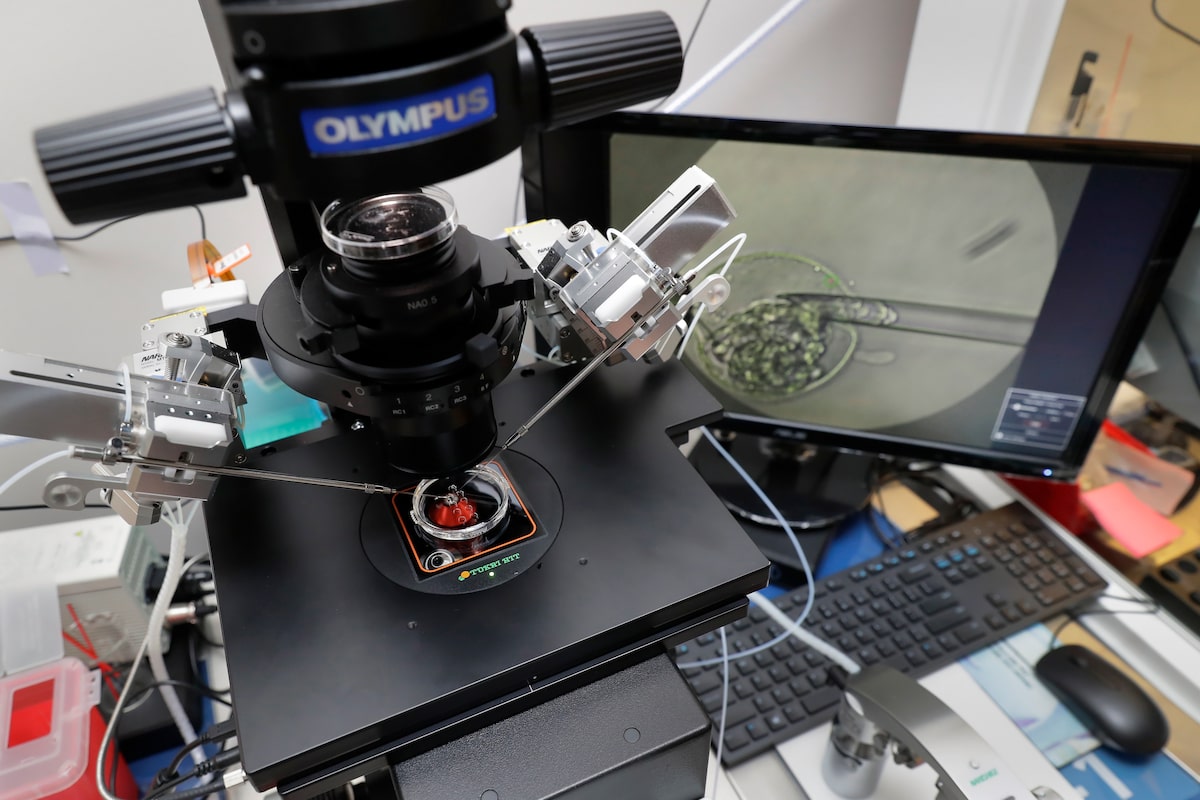Lab staff use a microscope stand and articulated hand controls to extract cells from embryos, shown on the monitor at right, that are then checked for viability.Michael Wyke/The Associated Press
Ontario announced on Wednesday that 25 fertility clinics will receive the first round of funding as a part of its $250-million plan to reduce waiting lists for in vitro fertilization and “triple” the number of families that can access expensive fertility treatments.
The announcement provided details from the province’s first major expansion of its Ontario Fertility Program, which launched in 2015 to help people struggling with infertility pay for procedures such as IVF.
Six of the 25 clinics will now join the program and receive funding for the first time. This brings the total number of participating clinics in Ontario to 54, Health Minister Sylvia Jones said at a press conference.
An initial $50-million allocation is estimated to cover an additional 5,000 cycles of IVF across the 25 clinics this fiscal year, the province said in a press release.
More clinics and their locations will be announced in the coming weeks, and the remaining $200-million will be rolled out in phases starting in 2026.
“Approximately one in six couples in Ontario experience infertility at some point in their lives,” Ms. Jones said. “This investment will expand clinic capacity and help triple the number of families across the province benefiting from publicly funded fertility supports.”
Demand for fertility treatments has soared since Ontario first began funding the procedures a decade ago. IVF is the most aggressive fertility intervention with the highest success rates, but can be prohibitively expensive for many people. In Ontario, one cycle of IVF costs about $20,000, said Carolynn Dubé, executive director at Fertility Matters Canada, an advocacy organization.
Last December, the province said an estimated 18,300 Ontarians were on waiting lists for government-funded IVF. Waiting times were about 20 months long.
But historically, Ontarians had to wait anywhere from one to three years before accessing publicly funded IVF, said Prati Sharma, president of the Canadian Fertility and Andrology Society and a fertility doctor with CReATe Fertility Centre, one of the clinics that will receive expanded funding.
“Being told that there’s a wait list of two years, when [patients] are often already older when they’re trying, is a huge blow,” Dr. Sharma said. “The fact that we’re perhaps cutting wait lists in half is a really great move forward.”
Most medical interventions are time-sensitive, but this can be especially true when it comes to treating fertility, which declines with age, said Kim Garbedian, medical director of Pollin Fertility Clinic in Toronto, one of the six new clinics to join Ontario’s program.
“When you’re over 40, even three months might make a difference. So, it’s really important to get patients into treatment as soon as possible,” Dr. Garbedian said. “If they’re on a wait list for two years, they may – by the time they get the funding − no longer be able to have a child.”
Without funding, patients often go to extreme lengths to pay for fertility treatments. Through her advocacy work, Ms. Dubé has heard from patients who have resorted to everything from taking second jobs to selling their homes.
“For those who want a baby, building your family is arguably one of the most important parts of someone’s life,” she said. “When you know you need to access fertility care, it can overtake almost all aspects of your life.”
Dr. Sharma said she’s heartened to see Canadian governments recognizing infertility as a significant medical concern – especially at a time when other countries, such as the United States, are scaling back.
In British Columbia, a new funding program for IVF just started accepting its first applications in July. Dr. Sharma would now like to see IVF funding introduced in every province and territory, and existing programs expanded to also cover procedures such as elective egg freezing.
“Seeing what’s happening in various provinces, this sort of movement to improve access and coverage really is great,” she said. “We’re at this tipping point in Canada.”
